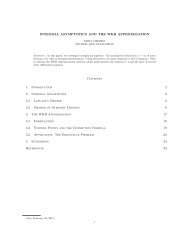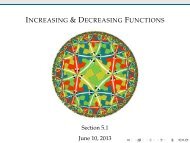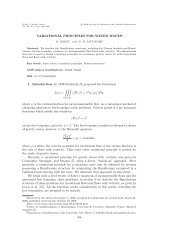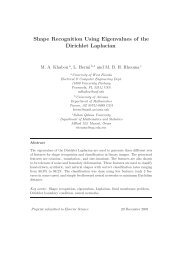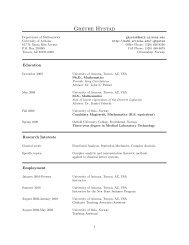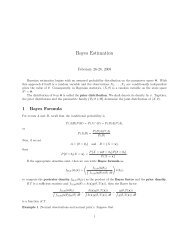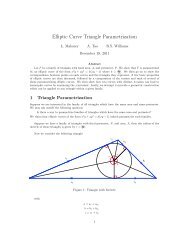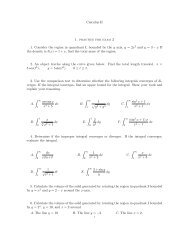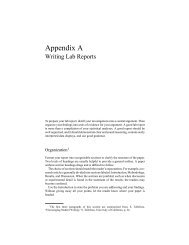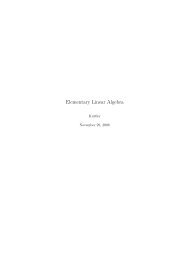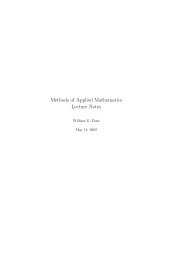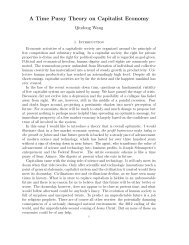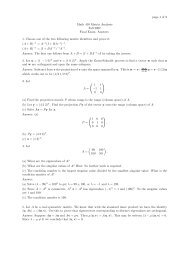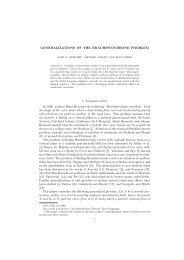Method of Moments
Method of Moments
Method of Moments
You also want an ePaper? Increase the reach of your titles
YUMPU automatically turns print PDFs into web optimized ePapers that Google loves.
Introduction to the Science <strong>of</strong> Statistics<br />
The <strong>Method</strong> <strong>of</strong> <strong>Moments</strong><br />
a census is not feasible. One estimation technique is to capture some <strong>of</strong> the animals, mark them and release them back<br />
into the wild to mix randomly with the population.<br />
Some time later, a second capture from the population is made. In this case, some <strong>of</strong> the animals were not in the<br />
first capture and some, which are tagged, are recaptured. Let<br />
• t be the number captured and tagged,<br />
• k be the number in the second capture,,<br />
• r be the number in the second capture that are tagged, and let<br />
• N be the total population size,<br />
Thus, t and k is under the control <strong>of</strong> the experimenter. The value <strong>of</strong> r is random and the populations size N is the<br />
parameter to be estimated. We will use a method <strong>of</strong> moments strategy to estimate N. First, note that we can guess the<br />
the estimate <strong>of</strong> N by considering two proportions.<br />
the proportion <strong>of</strong> the tagged fish in the second capture ⇡ the proportion <strong>of</strong> tagged fish in the population<br />
r<br />
k ⇡ t N<br />
This can be solved for N to find N ⇡ kt/r. The advantage <strong>of</strong> obtaining this as a method <strong>of</strong> moments estimator is<br />
that we evaluate the precision <strong>of</strong> this estimator by determining, for example, its variance. To begin, let<br />
⇢ 1 if the i-th individual in the second capture has a tag.<br />
X i =<br />
0 if the i-th individual in the second capture does not have a tag.<br />
The X i are Bernoulli random variables with success probability<br />
P {X i =1} = t N .<br />
They are not Bernoulli trials because the outcomes are not independent. We are sampling without replacement.<br />
For example,<br />
P {the second individual is tagged|first individual is tagged} = t 1<br />
N 1 .<br />
In words, we are saying that the probability model behind mark and recapture is one where the number recaptured is<br />
random and follows a hypergeometric distribution. The number <strong>of</strong> tagged individuals is X = X 1 + X 2 + ···+ X k<br />
and the expected number <strong>of</strong> tagged individuals is<br />
µ = EX = EX 1 + EX 2 + ···+ EX k = t N + t N + ···+ t N = kt<br />
N .<br />
The proportion <strong>of</strong> tagged individuals, ¯X =(X1 + ···+ X k )/k, has expected value<br />
Thus,<br />
E ¯X = µ k = t N .<br />
N = kt<br />
µ .<br />
Now in this case, we are estimating µ, the mean number <strong>of</strong> recaptured with r, the actual number recaptured. So,<br />
to obtain the estimate ˆN. we replace µ with the previous equation by r.<br />
ˆN = kt<br />
r<br />
To simulate mark and capture, consider a population <strong>of</strong> 2000 fish, tag 200, and capture 400. We perform 1000<br />
simulations <strong>of</strong> this experimental design. (The R command rep(x,n) repeats n times the value x.)<br />
199



